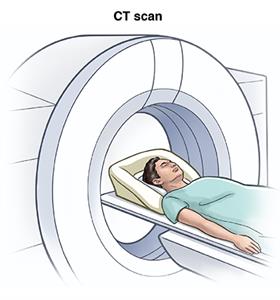A
B
C
D
E
F
G
H
I
J
K
L
M
N
O
P
Q
R
S
T
U
V
W
X
Y
Z
Click a letter to see a list of conditions beginning with that letter.
Click 'Topic Index' to return to the index for the current topic.
Click 'Library Index' to return to the listing of all topics.
Spinal Arteriovenous Malformations
What is a spinal arteriovenous malformation?
Arteriovenous malformations (AVMs) occur when the connections between the veins and arteries don't form the right way. The vessels become entangled. Often, these abnormalities develop in the fetus, or in a newborn baby.
AVMs can occur anywhere in the body. When they happen in the spinal cord and brain, they are called neurological AVMs. These are more likely to cause symptoms in different parts of your body.
What causes spinal AVMs?
AVMs are equally common among different races and ethnicities. Most people don't even know that they have a spinal AVM. It may be found during treatment or diagnosis for another condition.
Spinal AVMs can cause problems with circulation because they interfere with your body's blood flow. Normally, your arteries transport oxygen-rich blood away from your heart and to cells throughout your body. Your veins carry that blood, with its oxygen stores used up, back to your lungs and heart. But the malformations of your arteries and veins in spinal AVMs don't allow this natural cycle to occur because of missing capillaries, which regulate blood flow.
Spinal AVMs can be serious if they rupture. They can cause bleeding into surrounding areas. They can also cause symptoms by compressing or diverting blood from parts of your spinal cord.
What are the symptoms of spinal AVMs?
Spinal AVMs often don’t cause any symptoms. When they do, they're usually minor and hard to notice. In a few people, though, the symptoms can be bad enough to affect their ability to function.
These are the most common symptoms of a spinal AVM:
-
Muscles that feel weak or become paralyzed
-
Stiffness in the legs, causing trouble walking
-
Abnormal control of bowel and bladder
-
Problems with balance and coordination (ataxia)
-
Pain or unusual feelings throughout your body, such as tingling or numbness
How are spinal AVMs diagnosed?
If you have symptoms, your healthcare provider may use these tests to find out if you have a spinal AVM:

How are spinal AVMs treated?
Treatment depends on the location and type of AVMs you have and the symptoms they cause. Many people have some improvement in symptoms after the AVM is fixed. You may need:
-
Surgery. A neurosurgeon removes the AVM.
-
Endovascular embolization. This is less invasive than surgery. A radiologist uses a catheter (small, thin tube) to inject an embolizing material to close off certain vessels.
-
Radiation therapy. Focused energy is used to damage and seal off the abnormal vessels.
-
Certain medicines. Your healthcare provider may give you medicines to treat symptoms, such as back pain.
What are possible complications of spinal AVMs?
If spinal AVMs aren't treated, they may cause damage to your spinal cord because it can't get the oxygen it needs from your blood. A spinal AVM may also bleed.
Living with spinal AVMs
Even though a spinal AVM may not always cause symptoms, it can still be dangerous, particularly if it starts to cause symptoms. Your healthcare provider should check any suspicious symptoms you have. These may include:
-
Muscles that feel weak
-
Muscle paralysis
-
Difficulty with balance and coordination (ataxia)
-
Unusual sensations, such as numbness or tingling, or pain
When should I call my healthcare provider?
Your healthcare provider should evaluate any signs or symptoms that indicate a problem with your nervous system, such as:
-
Headaches that won't go away
-
Seizures
-
Problems controlling your muscles, or muscles feel weak or paralyzed
-
Problems with balance and coordination
-
Pain or unusual sensations, such as numbness or tingling in your body
-
Stiffness in the legs, causing trouble walking
-
Abnormal control of bowel and bladder
Key points about spinal AVMs
-
AVMs occur when the connections between veins and arteries don't form the right way. The vessels become entangled.
-
AVMs can occur anywhere in your body. But when they happen in the spinal cord and brain, called neurological AVMs, they are more likely to affect different parts of your body.
Next steps
Tips to help you get the most from a visit to your healthcare provider:
-
Know the reason for your visit and what you want to happen.
-
Before your visit, write down questions you want answered.
-
Bring someone with you to help you ask questions and remember what your provider tells you.
-
At the visit, write down the name of a new diagnosis and any new medicines, treatments, or tests. Also write down any new instructions your provider gives you.
-
Know why a new medicine or treatment is prescribed and how it will help you. Also know what the side effects are.
-
Ask if your condition can be treated in other ways.
-
Know why a test or procedure is recommended and what the results could mean.
-
Know what to expect if you do not take the medicine or have the test or procedure.
-
If you have a follow-up appointment, write down the date, time, and purpose for that visit.
-
Know how you can contact your healthcare provider if you have questions, especially after office hours or on weekends.
Online Medical Reviewer:
Joseph Campellone MD
Online Medical Reviewer:
Marianne Fraser MSN RN
Online Medical Reviewer:
Raymond Kent Turley BSN MSN RN
Date Last Reviewed:
8/1/2023
© 2000-2024 The StayWell Company, LLC. All rights reserved. This information is not intended as a substitute for professional medical care. Always follow your healthcare professional's instructions.